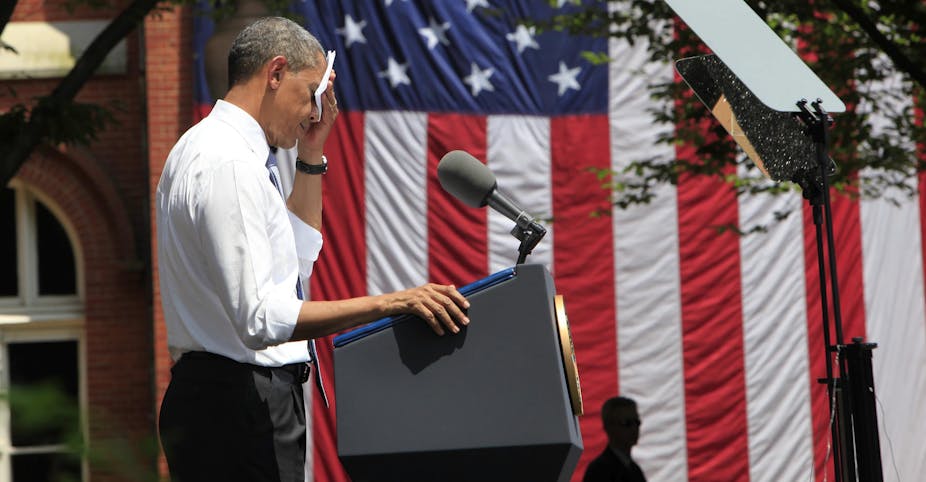President Obama’s speech at Georgetown University yesterday marks the most significant development in US climate change action so far. The “President’s Climate Action Plan”, a 21-page document, sets out Obama’s vision for addressing climate change and builds on the strong commitments in his inauguration and the State of the Union (SOTU) speeches that he would take action.
The plan sets out the measures the Administration can implement without Congress support, and confirms Obama’s willingness to act alone. Significantly, Obama appeals to the American public’s moral responsibility with a plan sub-titled “taking action for our kids”.
Obama frames the challenge in positive terms, and calls for America to harness its “unique strengths” to address it. He identifies scientists, farmers, engineers, workers and businesses as the beneficiaries of an economy that runs on cleaner fuels. He also places equal emphasis on reducing emissions and adaptation.
First: cut pollution
Obama’s plan has three aims: to cut pollution in America, to prepare the United States for the impacts of climate change and to lead international efforts to combat global climate change. Obama’s mitigation actions consist of a long list of measures that together amount to a significant policy response. Perhaps most significant is the Presidential Memorandum to the EPA to work “expediously” to regulate emissions from existing coal power stations. These are the single largest source of America’s carbon emissions, accounting for one-third of all domestic greenhouse gas emissions.
The 1971 Clean Air Act provides the US EPA with the authority to regulate pollutants, including greenhouse gas emissions. The Obama Administration has already started imposing controls on new power plants, and today’s announcement is the first public confirmation that he plans to extend these controls to existing coal-fired power stations, with regulations to be finalised by 2014.
Obama points out “we have already set limits for arsenic, mercury and lead, but there is no federal rule to prevent power plants from releasing as much carbon pollution as they want”. These new limits are likely to lead to the closure or retrofitting of aging coal plants, as well as older natural gas plants.
Obama’s other mitigation measures include doubling renewable energy generation by 2020, building a 21st century transport sector, improving energy efficiency in buildings and appliances, and incentives for investment in clean technology and advanced coal projects. In particular, Obama has committed to permitting enough renewables on public lands to power 6 million homes by 2020 and to reduce carbon pollution by 3 billion metric tonnes cumulatively by 2030 through efficiency standards set over the course of the Administration for appliances and federal buildings. He also declared that he would reject the controversial Keystone pipeline if it was shown that the project would lead to significantly increased emissions.
Second: get ready for climate change
The Plan outlines 17 measures across three areas to increase resilience to climate change. They include building stronger infrastructure, protecting the economy and natural resources, and using sound science to manage climate impacts.
Given the spate of natural disasters recently experienced in the US (from Hurricanes Katrina and Sandy to rampant wildfires in California to droughts), there is concern about making energy, transport and building infrastructure more robust. Obama’s measures include making hospitals safer through a public-private partnership with the healthcare industry, piloting innovative strategies in Hurricane Sandy-affected areas to strengthen communities against floods and other extreme climate events, maintaining agricultural productivity by delivering tailored science-based knowledge to farmers, and launching a National Drought Resilience Partnership.
Third: lead the world
Finally, in recognising climate change is a global problem, the Plan commits to lead international efforts to address it. Leadership at the global level is much needed if a new international agreement is to be arrived at in 2015.
Obama has confirmed the US commitment to “forging a truly global solution to a global challenge”. With John Kerry as his Secretary of State, there is room for optimism on the international climate policy front. Obama also commits to focus on strengthening bilateral and regional partnerships with China, India and Brazil. He also proposes to lead global public sector financing towards cleaner energy by calling an end to US government support for new coal fired plants, except for the most efficient coal technology in the world’s poorest countries.
Instead of blaming inaction on a dysfunctional Congress, Obama has chosen to step up and lead on climate change both domestically and internationally. This is clearly an issue he is personally concerned about, and that will be an important aspect of his legacy as President.
While in the long run, Congress will have to act, Obama’s sweeping policy response will likely be sufficient to meet his climate reduction target of 17% below 2005 levels by 2020, and will set up the economy for deeper long term cuts. This sends a further signal to the coal industry and business, and many companies already committed to a green economy are well placed to take advantage of the opportunities. It should also provide the momentum for governments in other countries, such as Australia, to lead on climate change action.
Anyone who now claims that the US (and China) are not acting on climate change is simply living in the past.

